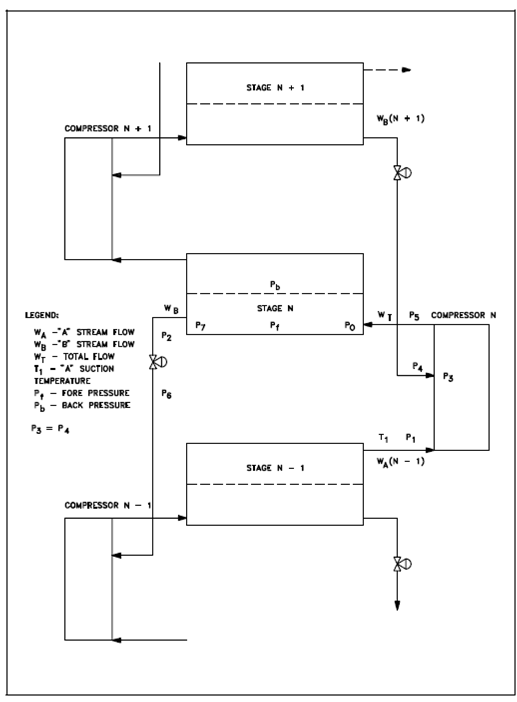Typical V-31 Stage:
Since of their number and complexity, the mathematical formulas used in calculating the pressure points within Figure will not be presented. The operator will read and record just those values that are measured through instruments and will not be needed to perform any of the mathematical calculations included in completing a circuit balance. Therefore, the following discussion will provide an indication as to the process included in determining these values. For compute a circuit balance for Stage N in another Figure, pressures P1 and P2 and temperature T1 are recorded. After that, knowing P 1 and T 1 and a constant previously determined within a test loop, it is probable to calculate the flow WA (N - 1). Because the "A" barrel of the compressor has basically a constant suction volume within the normal operating range, the inter stage flow is proportional to the compressor "A" suction pressure and temperature. Further, it is known in which the flow in a cascade must operate at a steady state condition to avoid an accumulation of deficiency of inventory within any one section. It might thus be supposed in which the flow downward to a stage is equivalent to the flow upward from the same stage. (This supposition is not valid for all stages in a cascade but for practical applications an error is negligible.) From this assumption, WB is equivalent to WA (N - 1). Along with P2, WB, and pressure drop data acquire within the test loop, P7 could be calculated.
In a test loop, data is taken on converters of different sizes and categories to determine pressure differences along with different amounts of flow and cut. If WA is found in the similar manner as WA (N - 1), it is then probable along with the test loop data to calculate Pb. Also, with the converter data, and knowing WB, P7, and WT (WT = WA + WB), Po and then, Pf are found.
Again using pressure drop data, P5 could be calculated from W T and P o. With P5, P3 is calculated through knowing the "B" pressure ratio of the compressor.
From the calculated values acquire from a circuit balance that is probable to make additional calculations that denotes the operational and productive features of the cascade. For instance, Pf, Pb, and the flows by a converter must be known before the real permeability of the barrier could be calculated. In addition, these values make it probable to accurately predict horsepower needs under varying conditions of flow and pressure. Another important application of the circuit balance is in the determination of inventory in the cascade whereas pressures and temperatures not otherwise measured are needed.

Figure: Pressures, Temperatures, and Flows in a Typical V-31 Stage